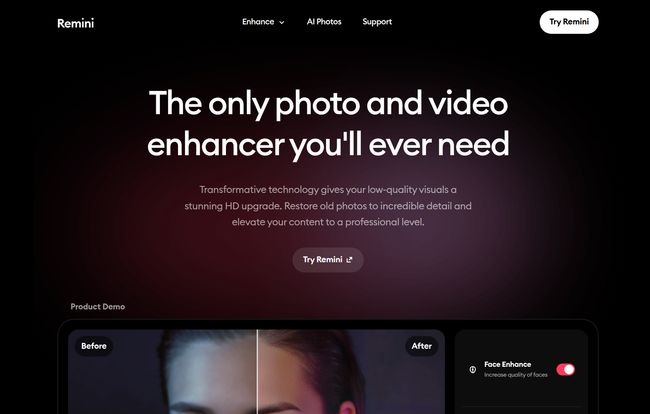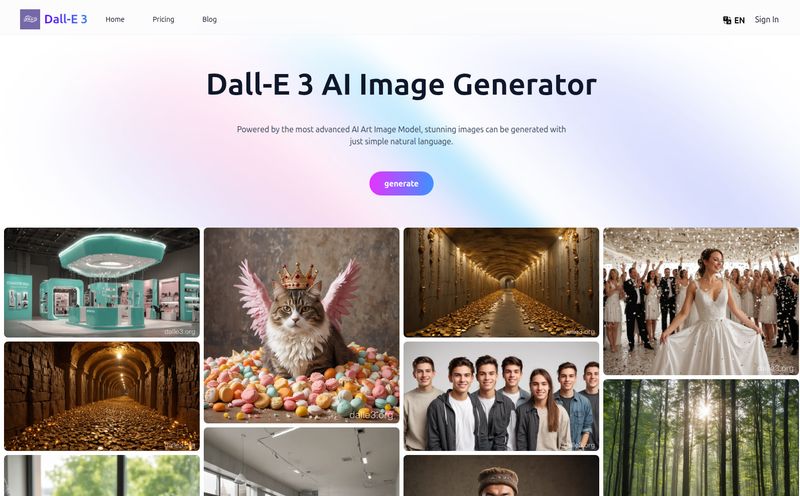We’ve all been there. You’re scrolling through your phone, stumble upon a photo from a few years back—a perfect moment, a hilarious face, a beautiful sunset—but it’s... fuzzy. A bit grainy. A victim of a less-than-stellar phone camera from a bygone era. Or maybe you're digging through a box of old family photos, treasures from your parents or grandparents, and you find a picture of a relative you never met, their face a blurry ghost. What if you could just… fix it?
For years, that meant firing up Photoshop and spending hours with the sharpen tool, cloning stamps, and a whole lot of prayer. But now, AI photo enhancers are everywhere, all promising to turn your digital duds into HD diamonds with a single click. The biggest name making waves in this space? Remini. With claims of over 100 million users and 5 BILLION photos enhanced, the hype is real. But as anyone in the SEO and digital marketing world knows, hype doesn’t always equal reality. So, I decided to take it for a spin. Does it actually work, or is it just more AI smoke and mirrors?
What Exactly is Remini? More Than Just a Filter.
First off, let's get one thing straight. Remini isn't your average Instagram filter that just slaps a color grade on your picture. This thing is doing some heavy lifting under the hood. The platform claims to use “state-of-the-art AI” to literally reconstruct images and videos. It’s not just sharpening edges; it’s analyzing faces, textures, and backgrounds to add detail that was lost or never even there to begin with. The tagline on their site says it all: “Bye-bye blur. Hello high definition.”
And it's not just for your blurry selfies. It’s designed to work on old printed photos, digital art, logos, and even videos. The promise is huge: take something old, grainy, or low-resolution and make it look like it was shot on modern gear. That's a bold claim. A really bold one.

Visit Remini
Putting Remini to the Test: A Look at the Key Features
A tool is only as good as its features, right? I messed around with a few different images to see where Remini really shines and where it kinda stumbles.
Breathing Life into Old Photos
This, for me, is the heart of what makes Remini special. The Old Photo Restoration and Color Fix features are the main draw for anyone with a box of family history sitting in the attic. I fed it a scanned, faded black-and-white photo of my great-uncle from the 50s. The kind of photo that's more emotional value than image quality.
The result was genuinely impressive. It didn't just sharpen his face; it seemed to understand the texture of his wool jacket and the light in his eyes. The colorization tool was a bit of a gamble—sometimes AI color can look plasticky—but it did a surprisingly tasteful job. It felt less like a cheap effect and more like a careful bit of digital archaeology. This is the feature that gets all the 5-star reviews saying “it’s magic,” and honestly, I get it.
The War on Blur and Noise
Okay, let’s talk about the more common problem: modern photos that just suck. The Unblur, Sharpen, and Denoise tools are for that concert photo you took in low light or the picture of your dog who refused to stay still. I tried it on a slightly blurry photo from a dinner party. Remini did a solid job of defining the edges and clearing up the digital “noise” without making it look overly processed or artificial. It's not going to save a photo that's a complete abstract mess, but for those slightly-off shots, it's a fantastic quick fix. Much faster than trying to do it manually.
From Photo Enhancement to AI Generation
This is where Remini steps into the very trendy world of generative AI. Beyond just fixing photos, it can create them. The AI Photos feature lets you upload selfies and generate professional-looking headshots or stylized avatars. We all saw this trend explode with apps like Lensa AI, and Remini has clearly jumped on board.
I think this feature is fun, but it's a different beast than the restoration tools. It’s more of a novelty for social media profiles than a practical tool, but it's a cool addition. The Face Enhance and Background Enhance features are more practical, allowing you to subtly improve portraits by smoothing skin (the ‘Pure Skin’ feature) or sharpening up a blurry backdrop. It’s all part of the same AI engine, just pointed at a different task.
The User Experience: Is It Really That Simple?
Yes and no. The core process is dead simple. You pick a photo, you press a button, you wait a few seconds, and you get a before-and-after slider. It’s incredibly satisfying. The app is available on both mobile and the web, which is a huge plus for flexibility.
But—and it’s a big but—if you’re on the free plan, get ready for ads. A lot of them. You’ll often have to watch a 30-second ad to process a single photo. It’s the classic freemium model: you pay with your time or your money. I can’t really fault them for it, servers and AI development aren’t cheap, but it can definitely slow down your workflow if you're trying to fix a bunch of photos at once.
Let’s Talk Money: The Elusive Remini Pricing
So, how much does it cost to go pro and ditch the ads? Good question. I went looking for a dedicated pricing page on their website, and you know what I found? A cute little 404 error page that said, “Oh no.. it broke!”
This is pretty typical for mobile-first apps. Instead of a public price list, they handle everything through in-app subscriptions on the Apple App Store or Google Play Store. From what I can gather, they usually offer weekly, monthly, and yearly subscription plans. These “Lite” or “Pro” plans remove the ads, get rid of wait times, and often give you more credits for things like the AI photo generation. You’ll have to open the app on your phone to see the current pricing for your region. Its a bit of a pain, but that's the model these days.
The Good, The Bad, and The AI-Generated
So, what’s the final verdict? Look, Remini is a genuinely powerful tool. The speed and quality of its enhancements, especially for old or blurry photos, can feel like pure sorcery. The sheer breadth of its toolset, from simple denoising to full-blown AI avatar creation, is impressive. For quick fixes and nostalgic projects, it’s fantastic.
However, it’s not infallible. Some might argue that relying purely on AI is a crutch. And they're not wrong. Sometimes the AI gets a little… creative. It might misinterpret a facial feature in a very blurry photo or make skin look a little too smooth, a little too uncanny. It’s a powerful sledgehammer, not a delicate scalpel. And of course, the ads in the free version can test your patience. It’s a trade-off you have to be willing to make.
Who is Remini Actually For?
In my opinion, Remini is perfect for a few key groups. Casual users who just want to rescue some old family photos will be blown away. Social media managers who need to quickly clean up user-generated content or create snappy profile pics will find it super useful. Even small e-commerce businesses could use the Image Enlarger to improve low-quality product photos. It’s a democratizing tool—it gives everyone access to photo restoration powers that used to be reserved for Photoshop pros.
Is It Worth the Hype?
After playing around with it for a while, I have to say… yeah, for the most part, it is. Remini isn't a replacement for a professional photo retoucher, but it was never meant to be. It's an accessible, fast, and often stunningly effective tool that puts real power in your pocket. It successfully bridges the gap between a simple filter app and complex desktop software.
Whether you stick with the ad-supported free version or spring for a subscription, you’re getting access to some seriously cool tech. Is it magic? Sometimes, it sure feels like it. And for that blurry photo of a long-lost relative, that feels like everything.
Frequently Asked Questions about Remini
- What is Remini best for?
- Remini truly excels at restoring old, blurry, or low-quality photos, especially portraits. Its face enhancement AI is its standout feature, making it ideal for bringing clarity to old family pictures.
- Is Remini completely free?
- There is a free version of Remini, but it is supported by ads and may have limits on the number of photos you can enhance per day. To remove ads and unlock all features, you'll need to purchase a subscription.
- Can Remini enhance videos too?
- Yes, one of Remini's key features is video enhancement. Similar to its photo capabilities, it can increase the resolution and clarity of old or low-quality video files.
- How does Remini's AI photo generation work?
- This feature uses generative AI. You upload several of your own photos (usually selfies), and the AI learns your facial features. It then creates brand new, high-quality images of you in various styles, such as professional headshots or fantasy-themed avatars.
- Are the results from Remini always perfect?
- While often impressive, the results are not always perfect. AI can sometimes misinterpret details in very damaged or blurry photos, leading to slightly unnatural or “uncanny” results. It’s best to view it as a powerful enhancement tool, not a miracle worker for every single image.
- Does Remini work on things other than photos of people?
- Absolutely. Remini can be used to unblur and enhance all sorts of images, including drawings, paintings, digital art, product images, and even logos by using features like the general Image Enlarger and Denoise.



